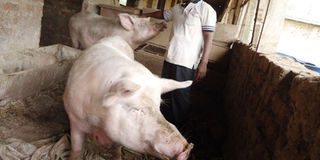African Swine Fever: Overcoming the setback

A farmer in Kayunga District inspecting his pigs. At the farm level, there is a number of ways farmers can keep the African swine fever at bay. FILE Photo
Piggery is a major farming activity in Uganda and one of the main sources of economic livelihoods for many households involved in the sector. For an indigenous pig breed, the least one can earn is Shs120,000 while for a cross breed, it can be Shs300,000 in less than six months.
However, during those times when there are dry spells, farmers have always had their pigs decimated by the incurable viral disease, African swine fever. It leaves farmers counting losses as there is no vaccine available for the control of African swine fever.
Daniel Ebeiru, an agriculture extension worker, explains that since the fever was detected way back in 1925, there is no viable vaccine available for it.
The virus can solely survive in the environment among ticks, and carcasses if not well disposed of. The disease can remain to haunt farmers even during mild weather.
Vicious cycle
Listening to testimonies from farmers who have suffered attacks of the disease on their farms, would discourage those interested in taking up piggery, because of the manner in which it spreads and kills the animals.
It is a highly contagious hemorrhagic disease caused by a virus. It is passed on to the pigs in a vicious cycle between soft ticks and wild pigs and direct contact with infected pigs.
While in its early stages, he explains, it causes pigs to develop high temperatures of about 40.5 degrees Celsius. And there are seemingly no noticeable symptoms in its early stages. “After a while they gradually lose appetite, and then become depressed. The white pigs turning bluish purple and bleeds become apparent on the ears and abdomen.”
Ebeiru adds that from a few days of showing symptoms, they die within a period of two to three weeks. On contracting the fever, the pregnant ones suffer abortions, have gummed up eyes, laboured breathing and will vomit and cough.
Control measures
Sam Ocen, veterinary doctor, says local farmers can manage the disease through confining their herds, restricting their movements, bury carcasses of the infected pigs, and carry out preliminary disinfection by spraying the premises.
“Even having water dips for your pigs has been proven effective more so in regions with high temperatures. The water helps cool the temperatures that have been proofed as an enhancer in accelerating the spread of African swine fever,” he notes.
As a precautionary measure, he advises those who intend to invest in piggery to also get to know the history of the farm before they buy young piglets for rearing. Farms that have been affected by African swine fever have high chances of harbouring the virus.
Some facts on African Swine fever in Africa
In several parts of Africa, pig keeping is a long-standing tradition. Rapid urban growth in recent years has given a strong impetus to pig production in and around cities and larger towns, where pigs have assumed great significance for food security among the less favoured sectors of the population.
Pork is one of the cheapest forms of animal protein available, since pigs can be raised successfully on food waste and other inexpensive fodder.
Rearing, managing and marketing pigs are activities increasingly undertaken by women and youth. African swine fever (ASF) is the main threat to the development of the African pig industry. Its destructive potential was fully appreciated when, in 1957, it made its first appearance outside Africa.
In Africa, re-emergence of the disease in 1994 has devastated pig production in many countries and the situation in others needs to be clarified.
Its extremely high potential for transboundary spread has placed all the countries in the region in danger and has raised the spectre of ASF once more escaping from Africa. It is a disease of growing strategic importance for global food security and household income.
The extremely rapid spread of ASF is due to its highly contagious nature and the ability of the virus to persist in a protein environment, including meat products, for long periods.
The fact that mortality is nearly 100 per cent creates an enormous surplus of dead pigs, which constitute a huge reservoir of virus. Since no vaccine exists, the only means of control is by compulsory slaughter, avoidance of which leads to clandestine movement of potentially infected pigs.
The most important factor that has been identified as contributing to the spread of this devastating disease is lack of early detection due to insufficient knowledge/experience on the part of farmers and pig breeders and among technical personnel regarding the manifestation of the disease.
Source: FAO




